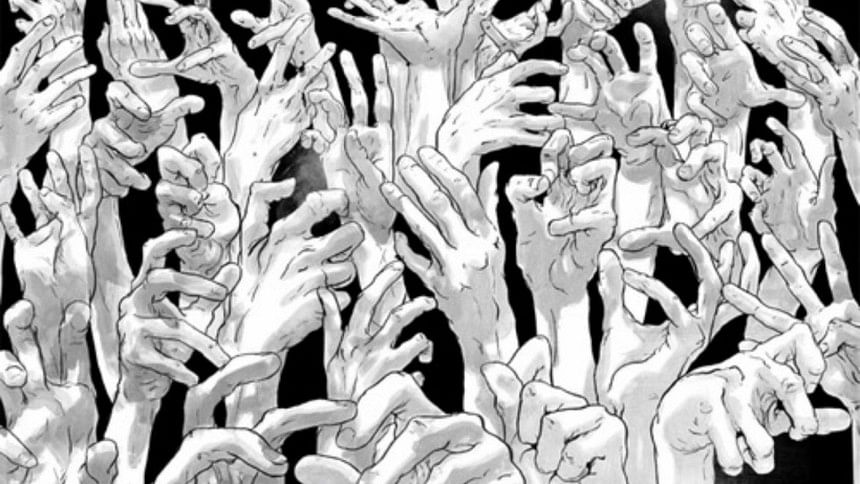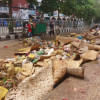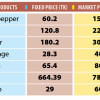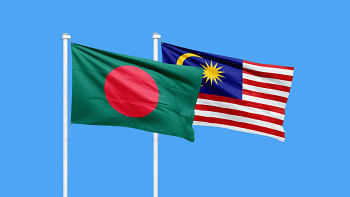Gory scenes that should have been avoided

This Eid, news updates and social media were flooded with gory images of the roads across some parts of Dhaka city. Accustomed as we all are to the sacrificial rituals of Eid-ul Azha, the concoction of stagnant rainwater and animal blood coursing through the streets was altogether too grotesque to tolerate, especially on as auspicious and festive an occasion as Eid. It begs the question of how such a situation was allowed to have surfaced; more importantly, how some people of this city could go so far as to deem the morbid debacle "artistic".
Every year we have been used to the stench and stains of animal blood and innards permeating the city after Eid rituals. Yet that did not make it any less shocking to watch as a combination of incessant rain, insufficient drainage and poor awareness measures resulted in a city marked red with the deluge of blood-soaked rainwater.
The appearance of the images on social media immediately sparked expected discussions of how Dhaka lacks the sufficient drainage system that could have prevented such scenes. As of June 2015, there were about 2.5 thousand water bodies and ditches in Dhaka; but it takes just a stroll around the city to notice how most of these remain congested with waste. It comes as no surprise that heavy rainfall would go on to flood our streets on a day already marked for additional waste in public areas.
While tackling Dhaka's drainage issues is a long-term issue, the city corporation's initiative to provide sites for the animal sacrifices on Eid was indeed noteworthy. Dhaka North and South Corporations were respectively allotted with 567 and 583 slaughter sites, along with the distribution of bio-degradable bags at cattle huts and information regarding available slaughter spots and the rates of butchers and imams on municipality websites. What's baffling is why the general public seems to have been unaware of such initiatives.
The city corporations should have spread enough media awareness regarding their measures, especially the availability of slaughter houses. In all probability many people would have taken them up on the offer and moved their Eid rituals to these sites, relieving the city of the harmful waste that is likely to cause diarrhoea, cholera, hepatitis and other water-borne diseases, especially for residents of the outskirts subject to poorer drainage facilities.
We're all too quick, however, to always point the finger at authorities and the parties "officially" responsible for taking care of the city, conveniently forgetting that we happen to be responsible for it too. While some of us may indeed have been unaware of the initiative, how many would actually have made use of it if it were more effectively publicised? Despite the obvious knowledge about the after effects of improper disposal of animal waste, animal sacrifices were seen to have been carried out at residential parking lots and streets in several parts of the city, with certain especially gruesome examples. Nazmul Abedin, a 23 year-old Dhaka resident, had to stop his car on his way to the outskirts because a recently sacrificed cow was right in the middle of the street, half submerged in bloody rainwater.
Bangladesh being home to a mostly Muslim population, the sacrifice of cattle is a core part of our religious beliefs and rituals. Those same rituals also demand that the animals not be slaughtered in the company of others animals – and that they essentially be treated with respect. It is shameful how some people have stooped to making social media posters out of the blood of sacrificed living beings.
Recent news updates and the consequent outcrop of filtered images of the coloured water on social media have tried to make light of the situation, implying that the original pictures were doctored and the spectacle was false. As much as we would like to believe that, the firsthand accounts and authentic images captured by eyewitnesses verify the uncomfortable truth.
While we hope that city officials will continue in their efforts to improve the sanitation and waste management systems with better resources and awareness campaigns in order to prevent future repetition of such hazardous scenarios, we must remember that a handful of government representatives will never succeed in keeping a city clean if the majority of its residents continue to soil it. If we want a clean city, we have no right to add to the dirt, and least of all to glorify it – whatever colour it may be.

 For all latest news, follow The Daily Star's Google News channel.
For all latest news, follow The Daily Star's Google News channel. 








Comments